The Michelin Guide began when the tire company — Michelin Tires — wanted to encourage travelers to drive to their destinations, in turn boosting car and tire sales. This helpful guide offered maps, attractions, and briefly mentioned places to stay and eat. The publication began as a travel guide to encourage day trips and now covers a range of prestigious ventures such as the flavor and personality of dishes at restaurants. Today, the coveted Michelin stars are awarded to the very best of the best restaurants.
According to The International Culinary Center, US-based restaurants only became eligible for Michelin stars in 2005, and the list continues to grow. The ratings range from one to three and rank the most sophisticated and successful restaurants around the world.
Bvlgari Hotels & Resorts is proud to announce that both the hotel’s signature restaurants, the Italian Il Ristorante — Niko Romito and the Chinese Bao Li Xuan, have been awarded Michelin stars during the Michelin Guide Shanghai 2020 presentation ceremony.
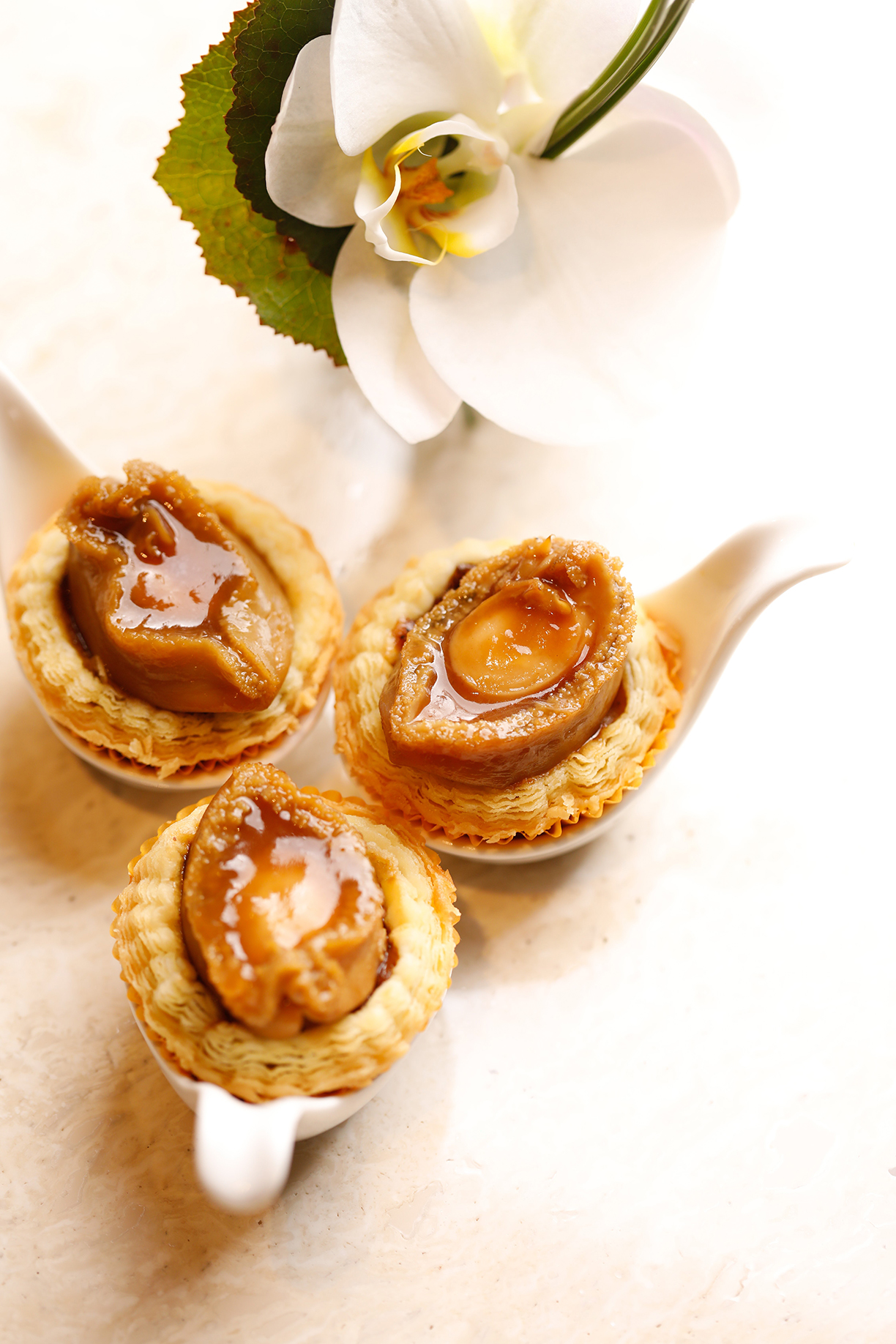
Bao Li Xuan — 1 Michelin Star
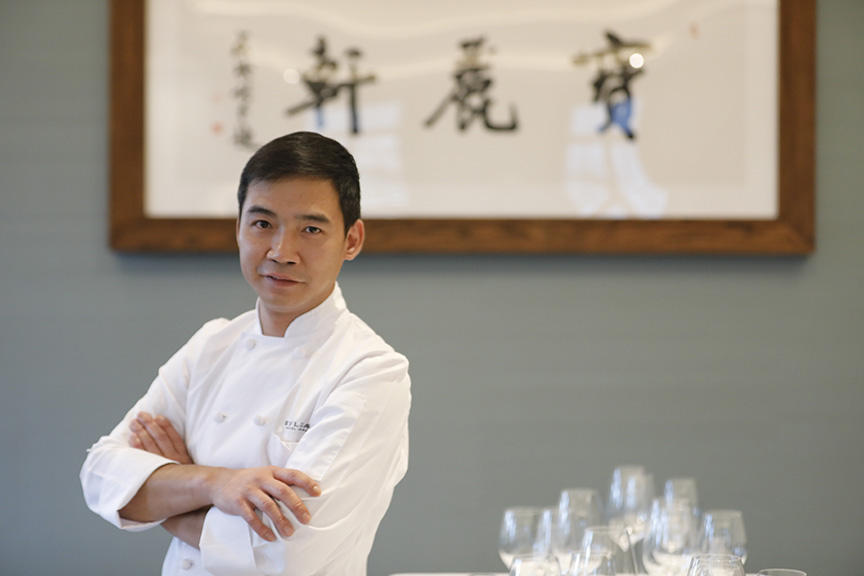
Located in Bvlgari Hotel Shanghai’s historic Chamber of Commerce Shanghai building, Bao Li Xuan will celebrate its first anniversary in October 2019. An enchanting blend of classic nostalgia and metropolitan modernity framed by its unique heritage setting dating back to 1916, the restaurant serves exquisite Cantonese cuisine prepared by Chef Fu from Hong Kong.
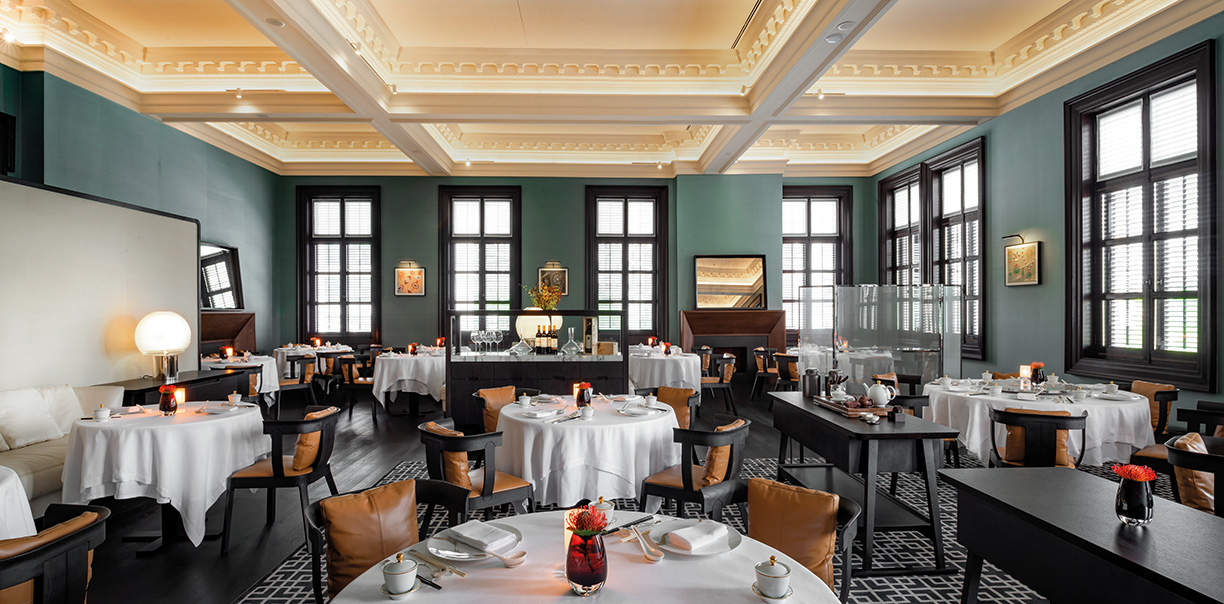
II Ristorante — Niko Romito — 1 Michelin Star
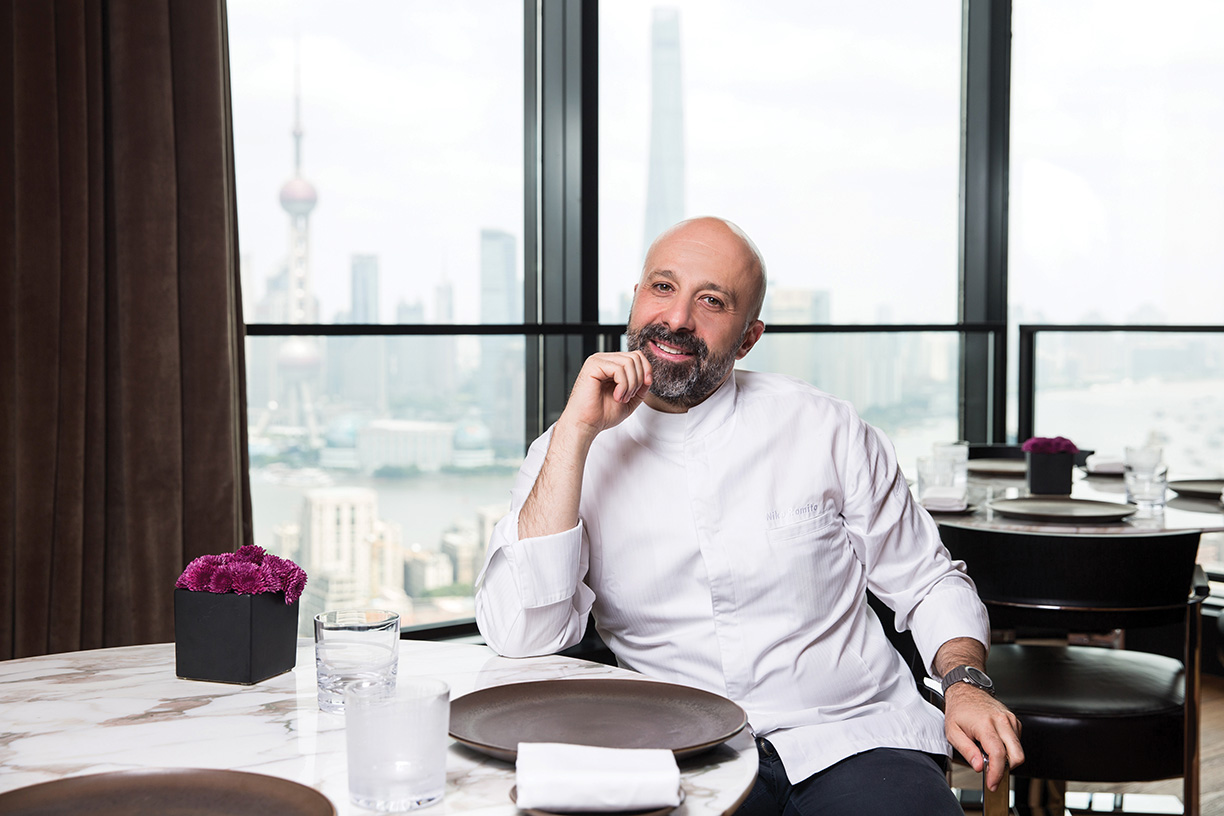
Il Ristorante — Niko Romito represents a unique collaboration between Bvlgari Hotels & Resorts and the renowned Italian chef-patron of 3 Michelin star restaurant Reale in Abruzzo. Showcasing a new gastronomic concept that the chef specially designed for Bvlgari Hotels & Resorts, Il Ristorante — Niko Romito is currently present in the Bvlgari properties of Dubai, Beijing, Shanghai, and Milan. Niko Romito is one of very few Michelin-awarded chefs in Italy to receive this prestigious acknowledgment by the Michelin Guide both in his home country and internationally.

Other Michelin Rated Restaurants To Try
Michelin Rated Italian
Giovannelli (Kerry, Ireland) — Italian cuisine crafted from homemade pasta and fresh local herbs.
Crust (Phuket, Thailand) — A cozy setting for Italian classics, such as scallops with truffle risotto and tiramisu.
Hos Thea (Oslo, Norway) — This small but well-established Italian restaurant only used the freshest ingredients.
Michelin Rated Chinese
Daguan Noodle (Chicago, Illinois) — Chinese cuisine with a twist on comfort, think rice noodles and steaming bowls of broth.
Duck & Rice (London, England) — A converted pub serving delectable Chinese classics with fireplaces and booths for added comfort.
Wei Lou (Seoul, South Korea) — Located on the 34th floor of Grand InterContinental Seoul Parnas, the spacious venue, delectable favorites make it ideal for large gatherings.
Photos courtesy of Bvlgari Hotels & Resorts
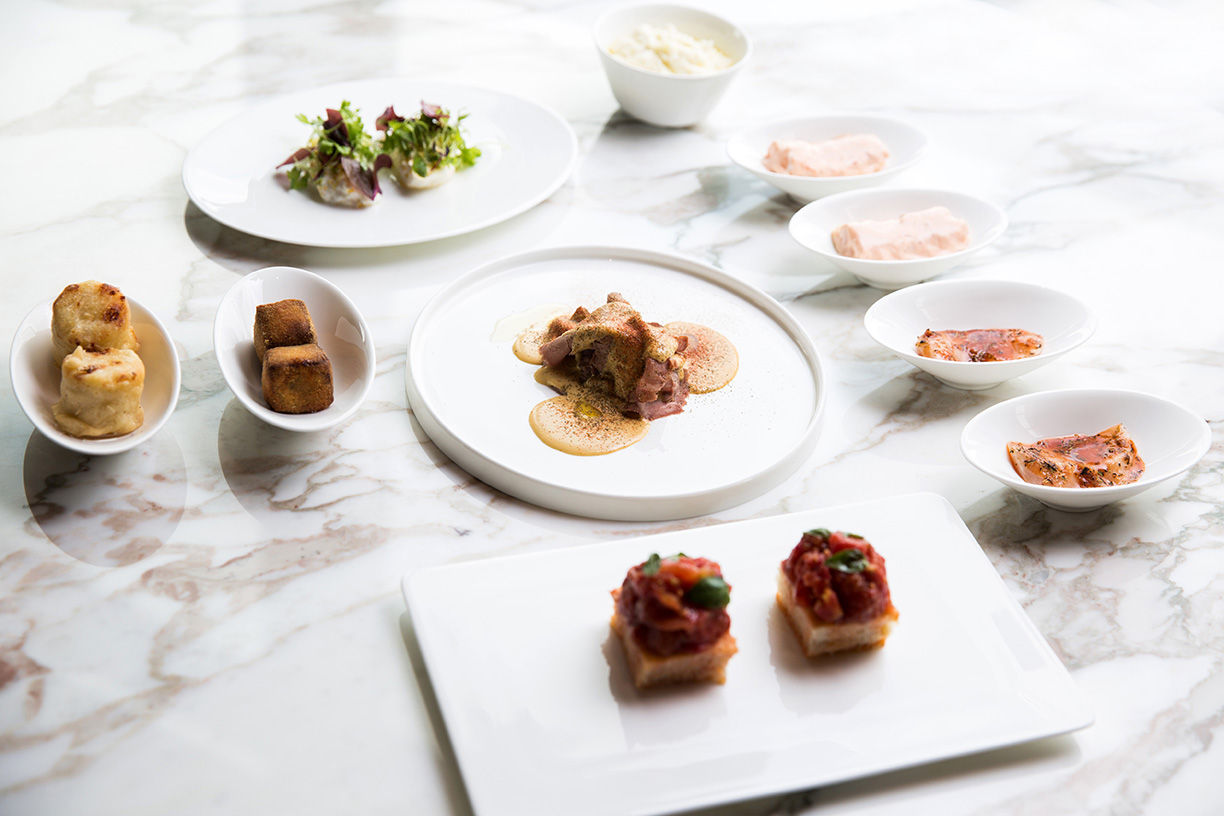
For similar content, try; Mainstream Middle Eastern, Cutting Edge, Catering to Today’s Food Trends, Gourmet Food Halls.
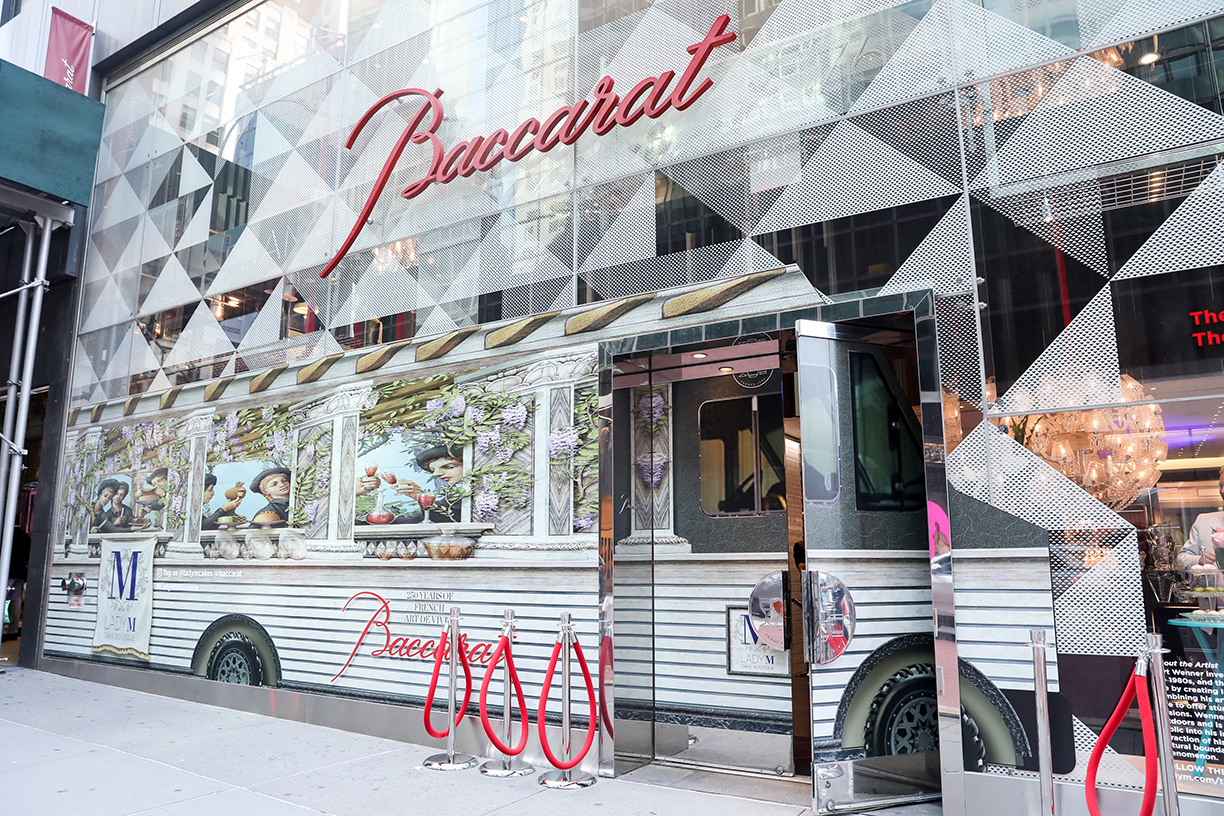
Lady M Cake Boutique, known for elegant, multi-layered Mille Crêpes cakes, has partnered with French luxury brand Baccarat to launch its first luxury cake truck in California.
Alongside 3D Artist Kurt Wenner, the five-year partnership will launch the cake truck in New York City at the Baccarat Boutique on Madison Avenue, and travel across the country before commencing operation in California. Set to start serving August 2019 in Northern California, the 28-foot multi-functional luxury cake truck will journey throughout California greeting new and existing clients of both brands with a unique cake experience.
“Baccarat is thrilled to be partnering with Lady M on this new and innovative collaboration,” says Jim Shreve, President and CEO of Baccarat North America. “Our partnership reinforces the Baccarat message of enjoying beautiful things every day. We are excited to share delicious cakes on beautiful Baccarat. Everything tastes better on Baccarat.”
From the sidewalk, pedestrians and guests will experience the Kurt Wenner 3D, life-sized rendering of the cake truck that will be affixed to the boutique’s glass façade. Inside, guests will meander through the boutique surrounded by Lady M cakes, capturing the feel of being in an actual Lady M boutique. Within the boutique, guests will be greeted with a glass of champagne as they approach yet another version of the cake truck, where Lady M Mille Crêpes will be served through a functional service window.
The Lady M x Baccarat cake truck is a stunning and luxurious feast for the eyes. On the exterior, Baccarat has mounted two large Tuile de Crystal Chandeliers ($29,100 each) and 1 small Tuile de Crystal ($12,600) that will gracefully hang suspended from two long beams that are collapsible when the food truck is not in service. Four Baccarat Mille Nuits Torch sconces ($2,150 each) will mount on either side of the service windows. During the day, Lady M will provide legendary service to clients who pre-order cakes. During the evening, Lady M and Baccarat will illuminate the night and create an outdoor dining experience for those who want to experience both brands.
“The collaboration with Lady M and Baccarat has allowed me to have an entirely new experience with interactive art. Placing my art on a food truck is a first for me,” says artist Kurt Wenner, who invented 3D Pavement Art in the 1980s. By combining his art with digital printing, Wenner offers stunning, durable, interactive illusions.
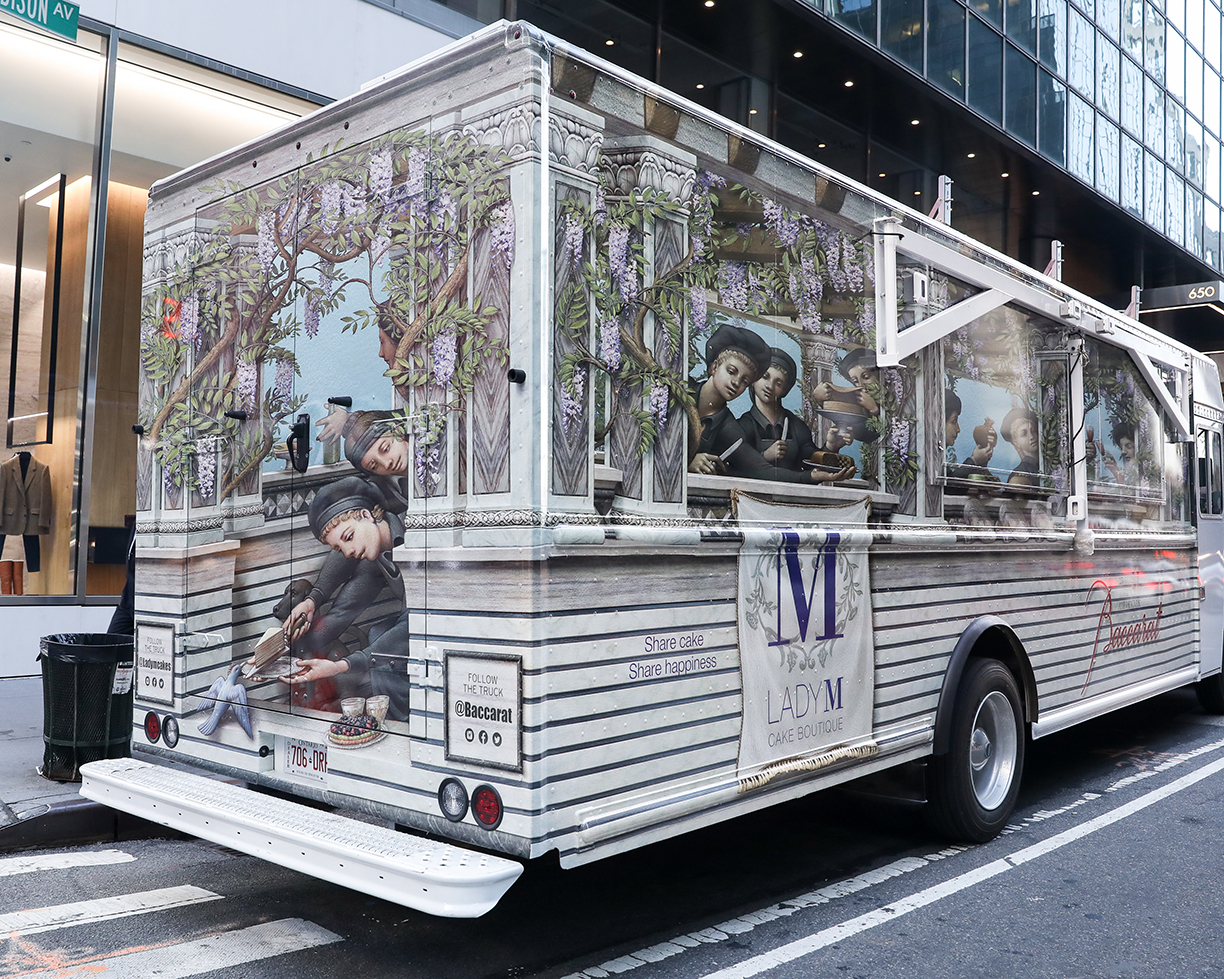
This collaboration is the first of its kind, and Lady M Cake Boutique is thrilled and honored to partner with Baccarat. We are excited to expand the concept of the Lady M experience and take our cakes (including a new confection made exclusively for the collaboration), on the road, introducing them to those both new to and familiar with the brand. We look forward to sharing our signature cakes on beautiful crystal, and sharing happiness.
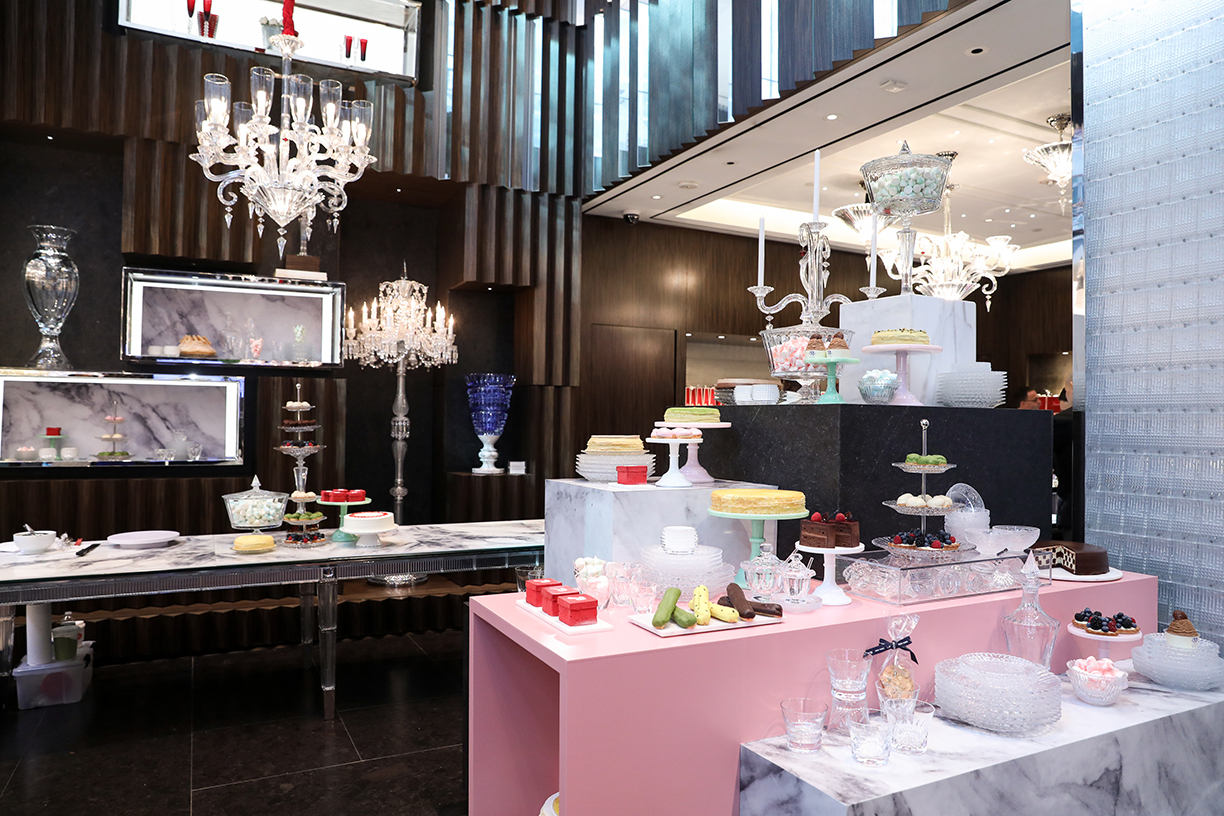
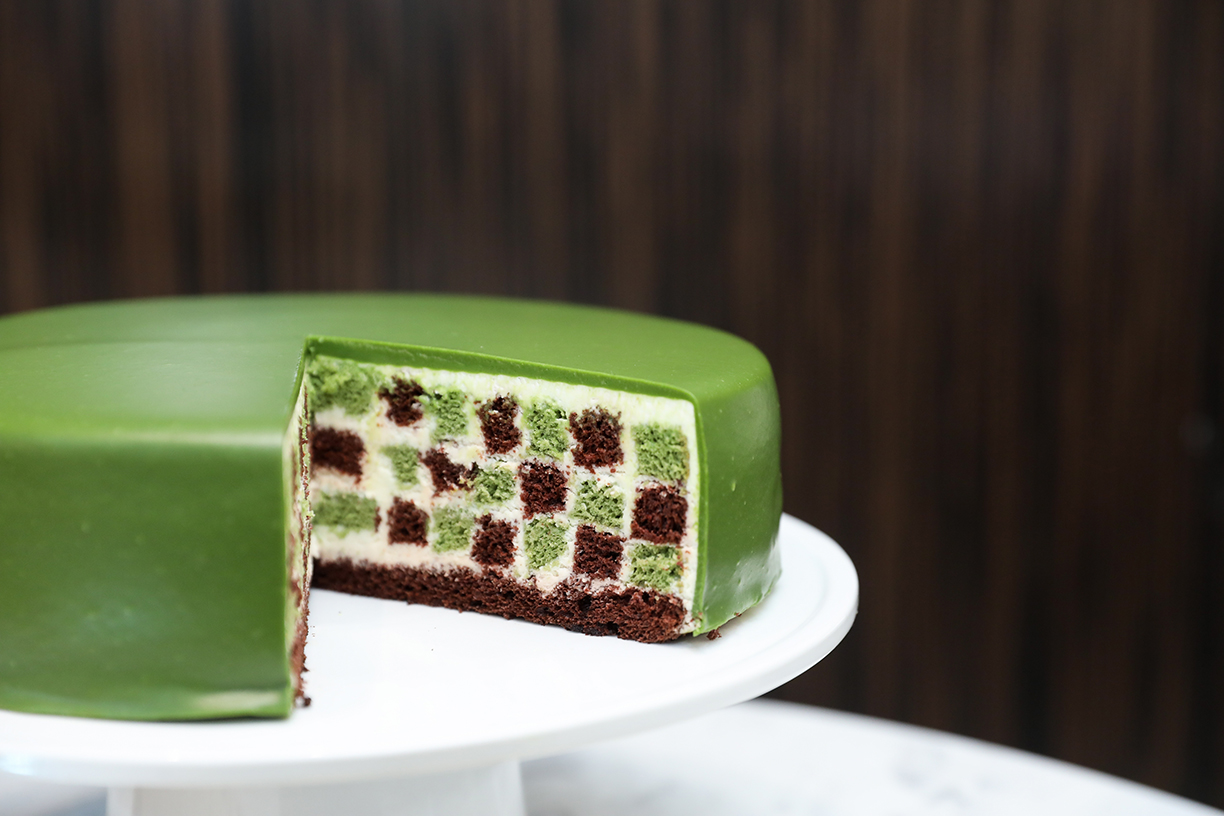

“My 3D illusions are where the language of proportion and innovation meet. I’m so excited about this project as the illusions I have created will be partnered with elegant chandeliers and the world’s finest cakes. The marriage of all three will shift the perception of what is reality,” says Wenner.
The cake truck will start service starting this month in Northern California, and guests are encouraged to tag and follow along with the hashtag #ladymxbaccarat. A microsite tracking the cake truck’s journey throughout California will be live at www.ladym.com/thecaketruck.
All photos courtesy Samantha Nandez / BFA.com
One of the world’s leading Peruvian restaurants, La Mar, by renowned chef Gastón Acurio, is announced as the latest culinary addition to The Royal Atlantis Resort & Residences, set to open late 2020.
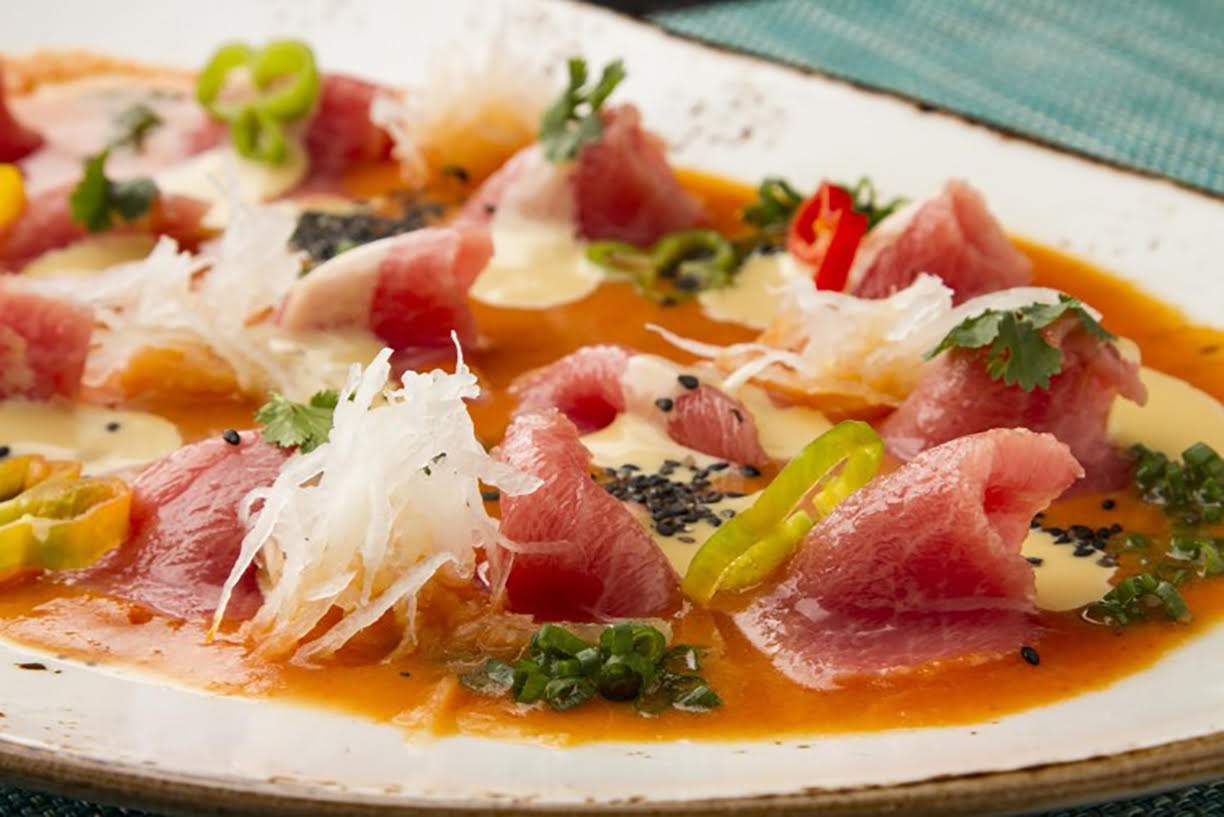
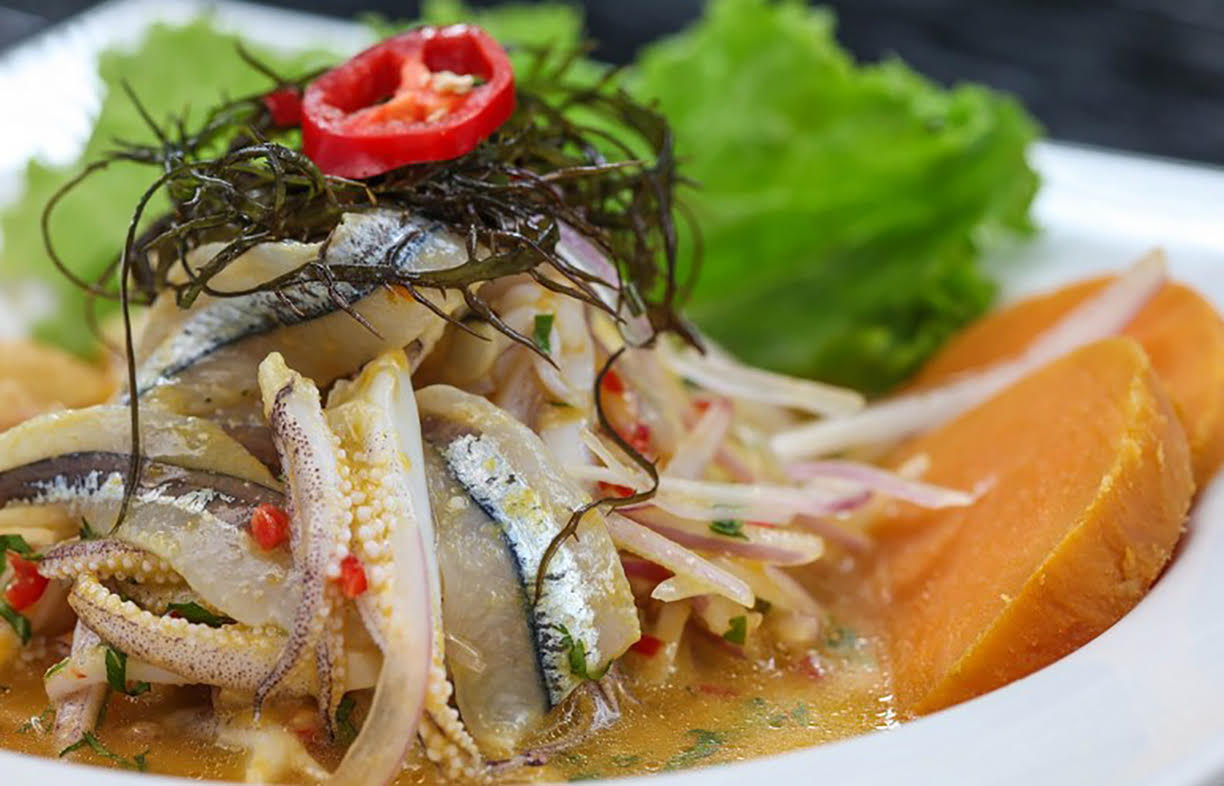
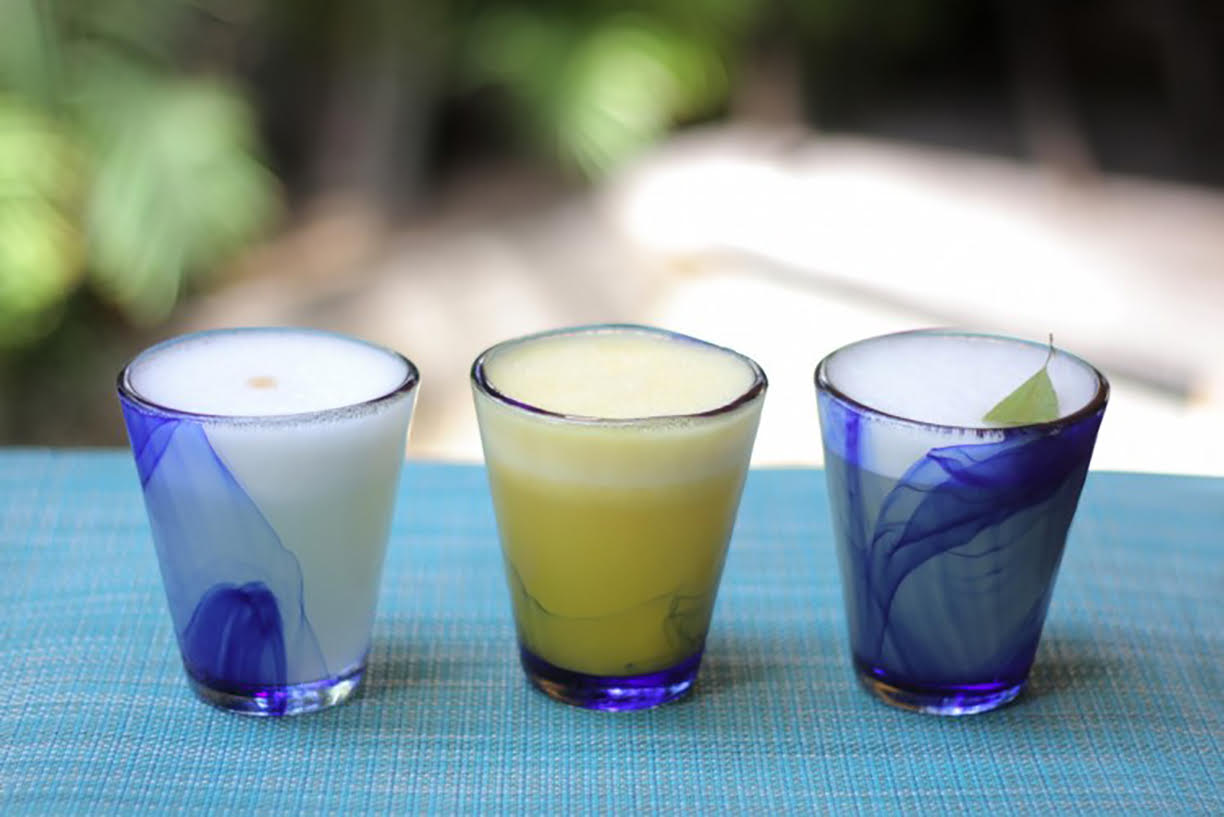
Celebrating the authentic and diverse flavors of Peruvian gastronomy, the restaurant’s contemporary design and elegant interior will provide the perfect backdrop for La Mar’s signature ceviche, freshly grilled anticuchos and pisco-led cocktails.
Renowned for his daring experiments using local ingredients, techniques and recipes, Acurio’s flagship restaurant won the No.1 spot on the inaugural Latin America’s 50 Best Restaurants list in 2013 and has held a place on The World’s 50 Best Restaurants list since 2011.
Now with over 50 restaurants worldwide, including three in America, Acurio has won the hearts and stomachs of worldwide food lovers with his unparalleled ceviche, unique Peking-style guinea pig pancake, and desserts inspired by his childhood. In 2018 Acurio was awarded The Diners Club Lifetime Achievement Award, regarded as one of the most prestigious accolades in the world of gastronomy.

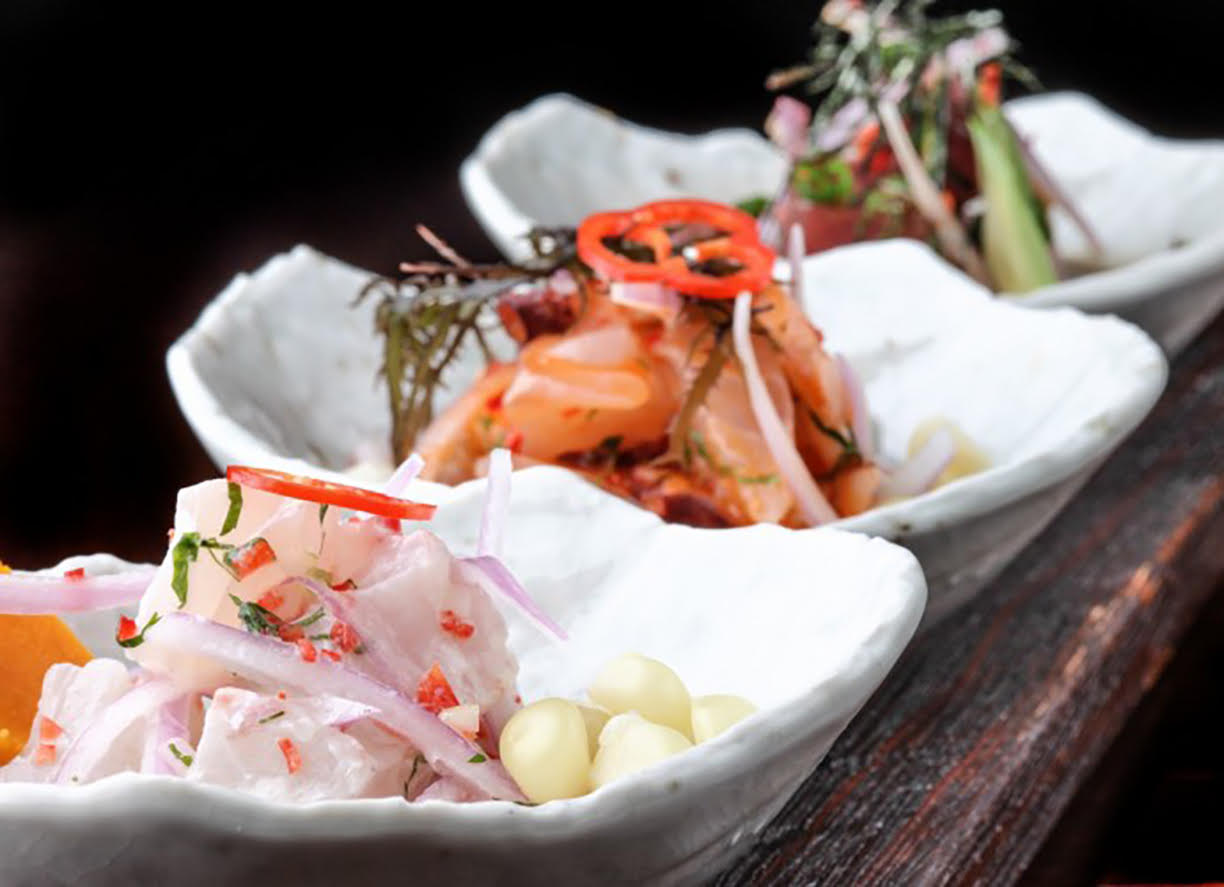
Located at mezzanine lobby level in The Royal Atlantis Resort and Residences, La Mar by Gastón Acurio will be the first traditional cebichería in Dubai, welcoming guests to an intimate space devoted to the South American tradition of ceviche and pisco sour. With a casual elegance and easy-going vibe, the signature features of La Mar will include an open kitchen, ceviche bar and an anticucho grill, where Acurio’s team of expert chefs will prepare marinated fish as well as tiraditos, causas and marinated anticucho skewers.
Inspired by the design of a ‘Fisherman’s Wharf’, guests will be greeted with a high cane ceiling upon entry with natural light spilling in from floor-to-ceiling windows overlooking the Palm Island via a large open terrace. Natural materials such as iron, cement, wood and stone complement a warm color palette of marine blues, green, sandy grey and beige evoking a sense of the ocean at every turn. Handcrafted and locally sourced tableware will emulate rock, coral, the seabed and shimmering fish scales.

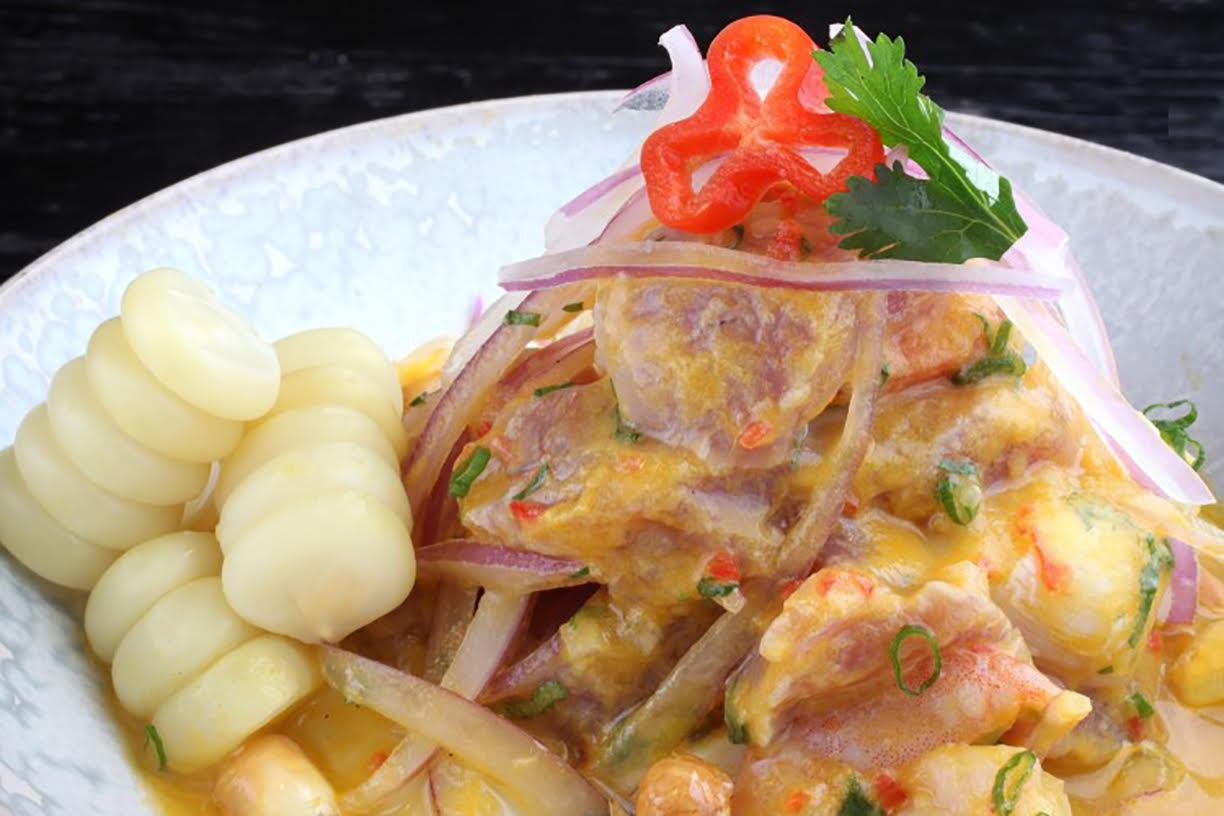
“Dubai is perhaps one of the cities with the greatest gastronomic activity in the world. The best restaurants and the most renowned chefs can be found in Dubai sharing their proposals and concepts with cosmopolitan diners who value and enjoy gastronomy as an activity that unites people and cultures.” — Gastón Acurio.
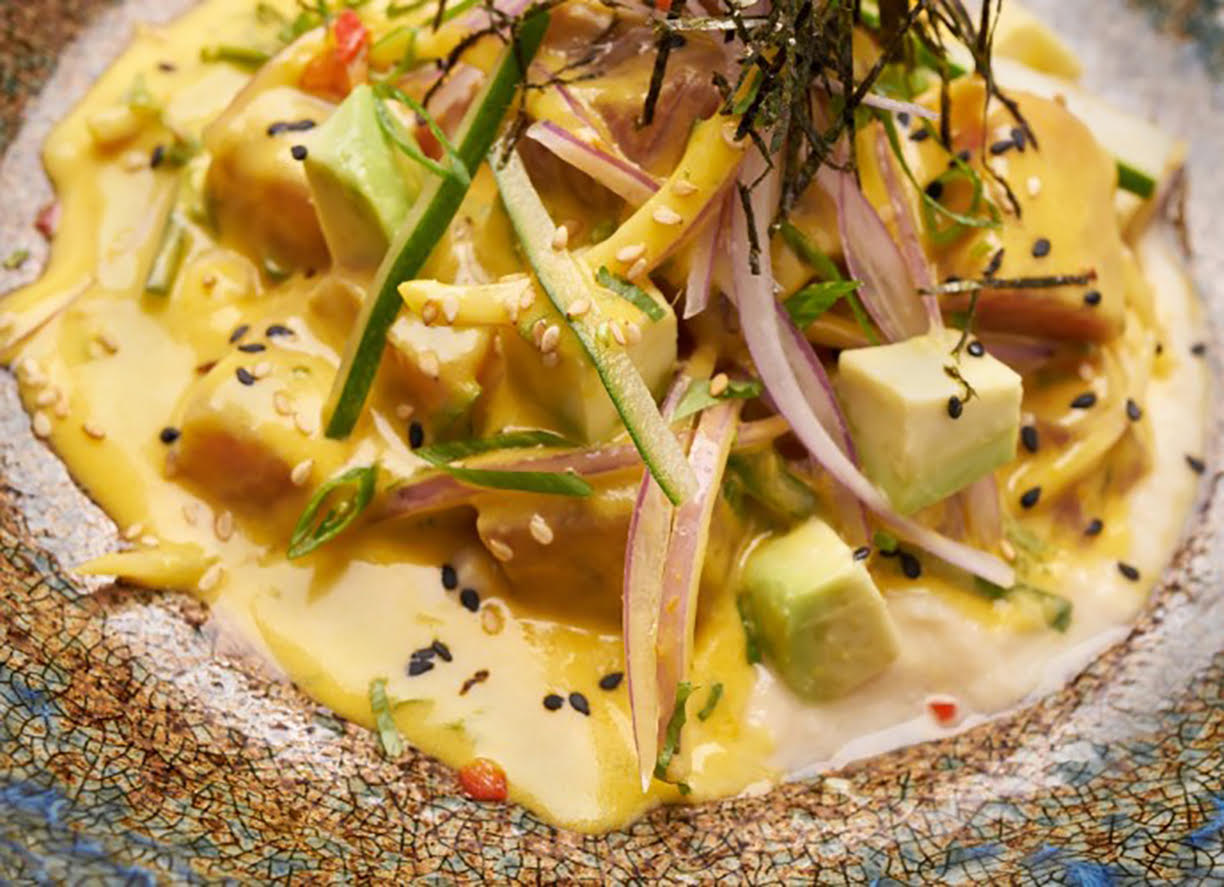
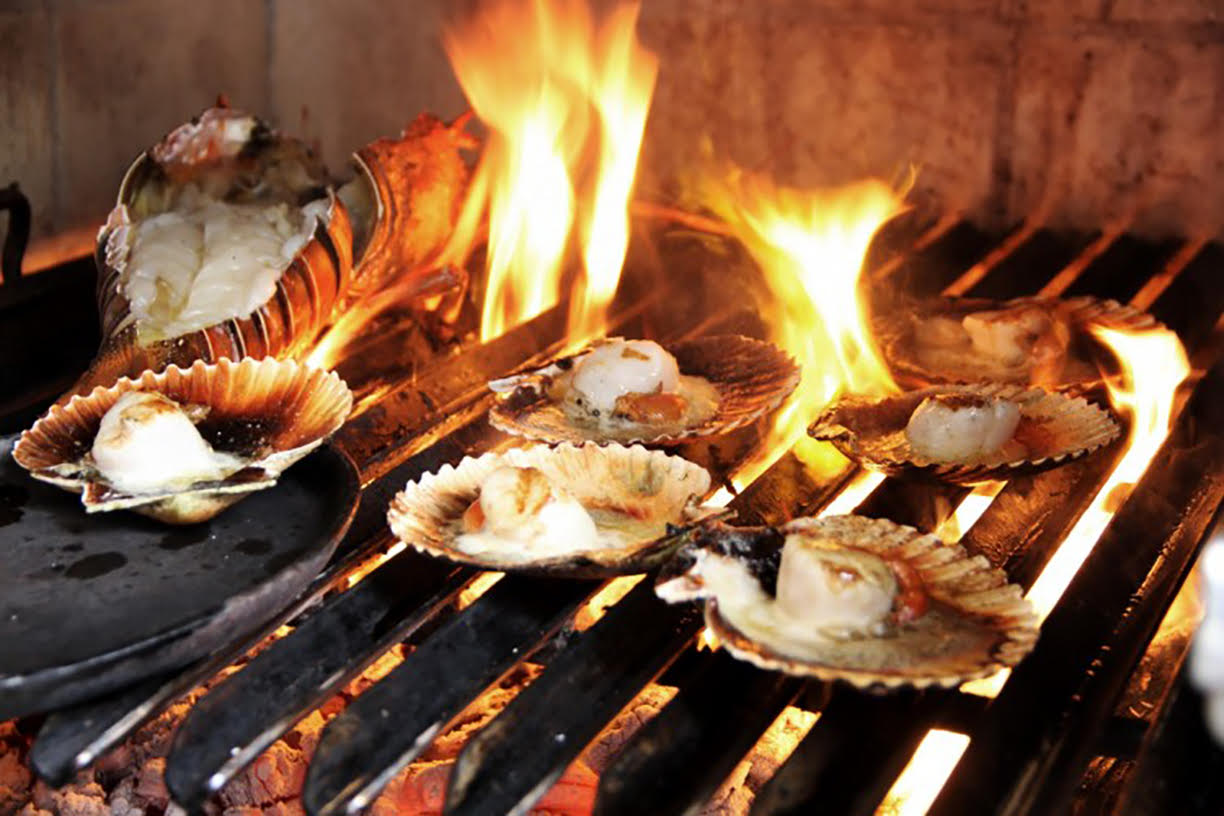
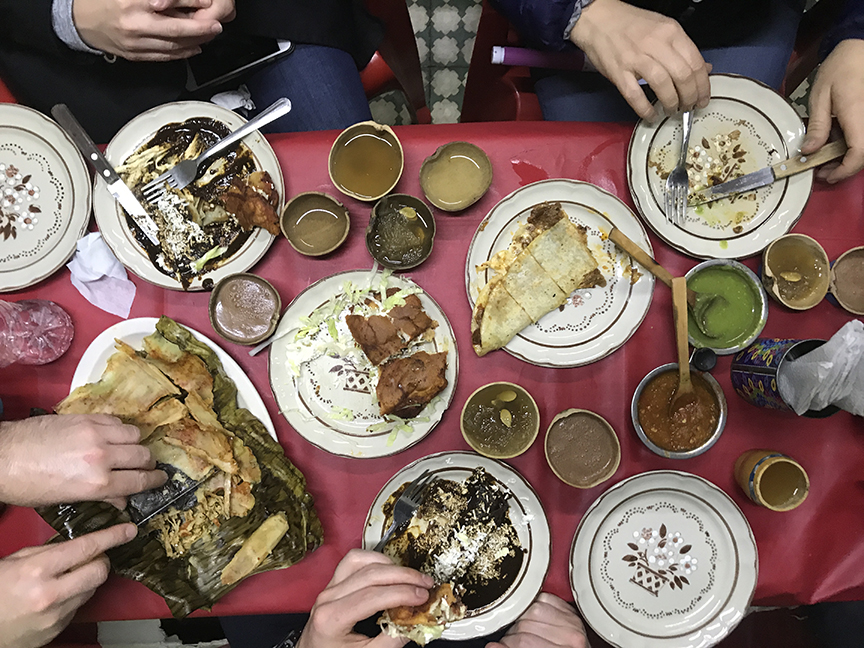
Consistently ranked among the top places to visit, Mexico City is a world capital welcoming more than 12.5 million visitors each year who come for its renowned cuisine, vibrant culture, rich history, unique neighborhoods and modern-day travel offerings. For an insider’s view of Mexico City’s food scene, Rocio Vazquez Landeta, founder of Eat Like a Local Mexico City, helps navigate travelers through the city’s neighborhoods to hidden culinary gems through her expert food tours, three of which will newly debut in 2019.
Born and raised in Mexico City, Landeta is a world traveler and food researcher, as well the owner of one of the first food blogs in Mexico, sin Mantel. After studying Mexican cuisine and culture at the Mexican Gastronomy School, she founded the company to take travelers through the streets of the vibrant Mexico City to taste, explore and connect with Mexico City’s food scene, markets, restaurants and people. “Food is an amazing tool because it is one of the few things that you can experience with all your senses. Through the food, we help travelers connect with the people behind the food. Through the food we create stories and we explain our roots and history.”
Discovering all the great places that only locals know, Eat Like a Local Mexico City’s food journeys showcase cutting-edge restaurants along with secret food stalls and street food that offer the most authentic Mexican cuisine.
The Mexico City Foodie Immersion tour covers all aspects of Mexican food. The 4.5-hour experience begins at a small coffee shop where travelers learn about the coffee culture in the city. With coffee in hand, the tour explores street food delicacies including Mixiotes, basket tacos, and rotisserie chicken. The journey continues to the subway to explore a traditional market with an array of carnitas, corn, tostadas, fruit and chorizo. Travelers then visit La Merced, the second biggest market in the city for candy tasting, pineapple juice, fish tacos and a visit to a local woman’s house for a homemade meal. The tour comes to an end at a hip, modern lounge for authentic cocktails.
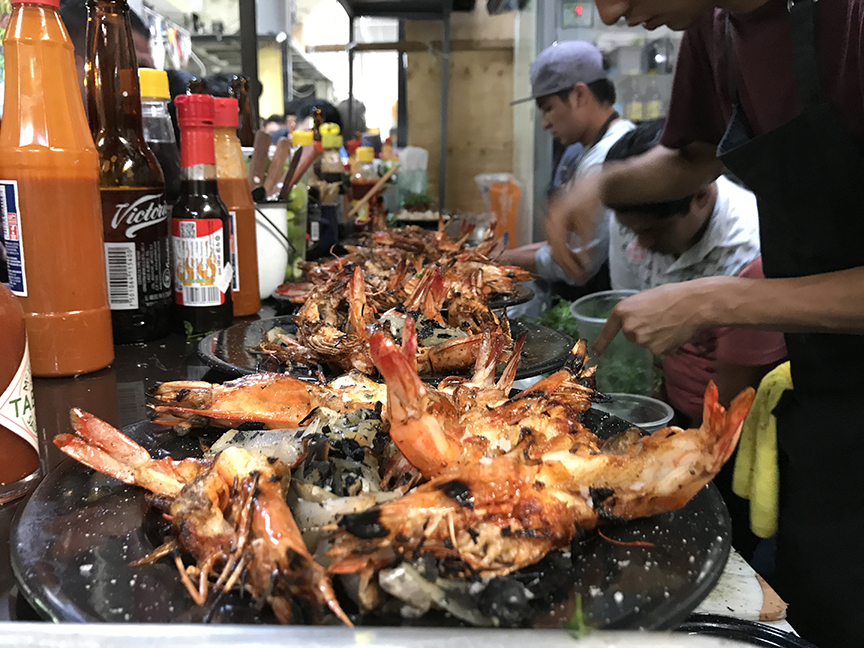
For the adventurous eaters, the Street Food at Night and Hidden Neighborhoods tour explores three hidden neighborhoods in Mexico City, San Rafael, Guerrero, Santa María la Ribera, and introduces foodies to eyeball and brains tacos. For the conservative eaters, enjoy al pastor or brisket tacos. Mole is the highlight of this tour and the group will eat traditional homemade black and yellow moles; taste mezcal, tejate, tepache, and other traditional Mexican drinks; and eat birria, chiles rellenos and churros. Finish the evening tour walking around the historic center and learn about Aztec legends while visiting the famous tile house.
However authentic the experiences are, Landeta’s passion for these tours extends further than the plate. “The food in Mexico City is of course is amazing, but our tours are more about getting to know the people behind the food,” she says, from hanging out with the locals, being hugged by the kids at the market and more. “Everybody says that they absolutely love the food, but what makes Eat Like a Local special is the people working with us — the guides, the vendors, the kids and the chefs.”
Eat Like a Local Mexico City is also the only Mexican-founded food tour agency that actively promotes economic growth and creates opportunities for families within the traditional markets. All of Eat Like a Local’s food tours support the local community. For example, the Mexico City Foodie Immersion tour supports the 80 IQ program, a program where 12 children at the La Merced Market learn English, receive monthly mentorship, participate in recreational activities and also, work as guides during the weekends. The Mexican Wine and Pulque Journey supports single mothers from La Merced Market through lending business advice and exposure, participation in pop-up events and mentorship. The Street Food at Night and Hidden Neighborhoods tour donates food and meals to homeless people as well.
In the end, everything comes back to the heart and home for Landeta. “Every dish has a soul, each cook creates dishes with his hands but also with his heart. Eat Like a Local creates a love affair with the food, but also with the people,” she says.
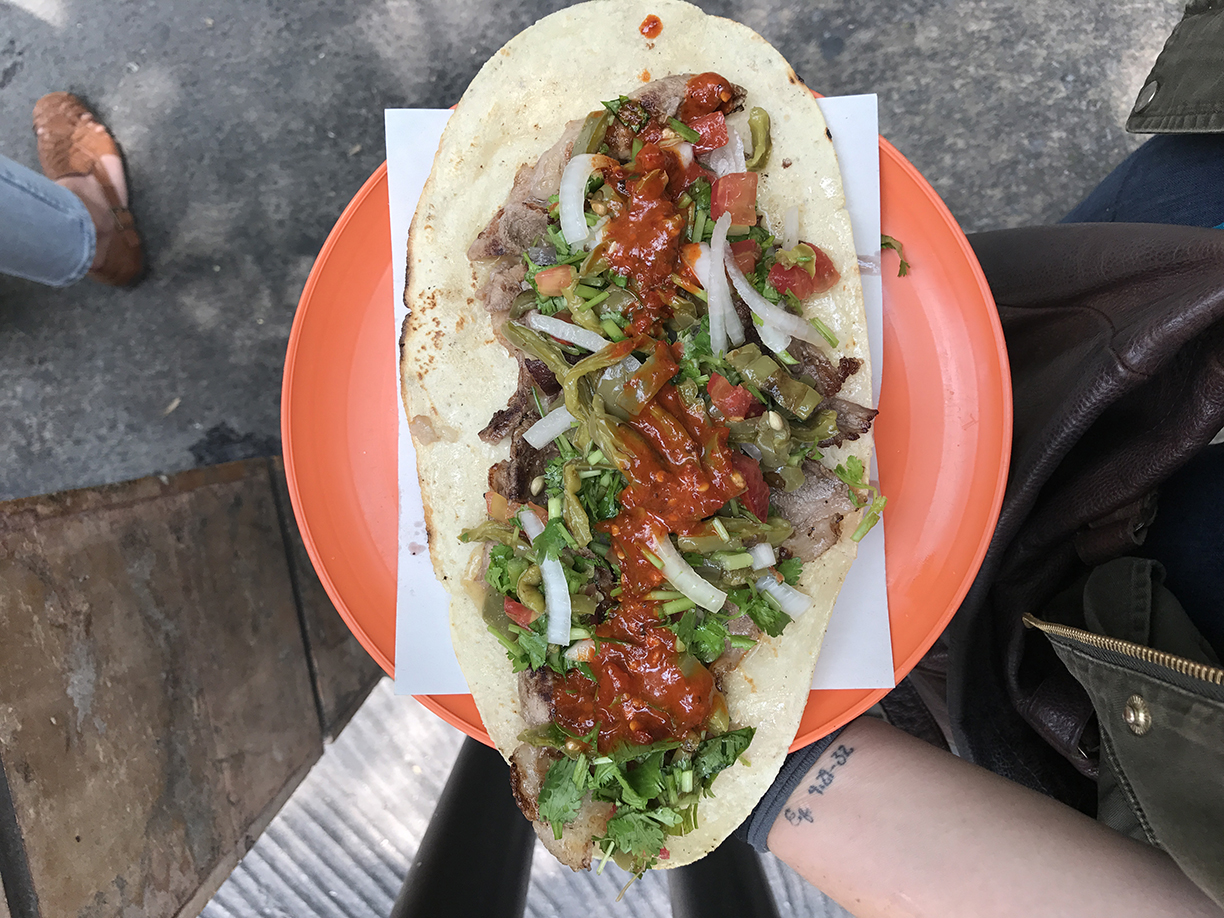
The Mexican Wine and Pulque Journey is hosted by Sara Garza, a sociologist who grew up in the Roma neighborhood. Guests explore Garza’s favorite spots including the traditional places she grew up eating at, as well as new, trendy hotspots. Starting at Eno, Enrique Olvera´s famous deli, taste green pozole, pastor tacos, Mexican-Argentinian tacos and more. Travelers will learn about Pulque, the pre-Hispanic drink made from the agave plant. End the afternoon at a winemaker´s shop where the group tastes four different Mexican wines paired with Mexican craft cheese. The tour unveils the hidden history behind the wineries and guests will learn about the Mexican wine world with an expert.
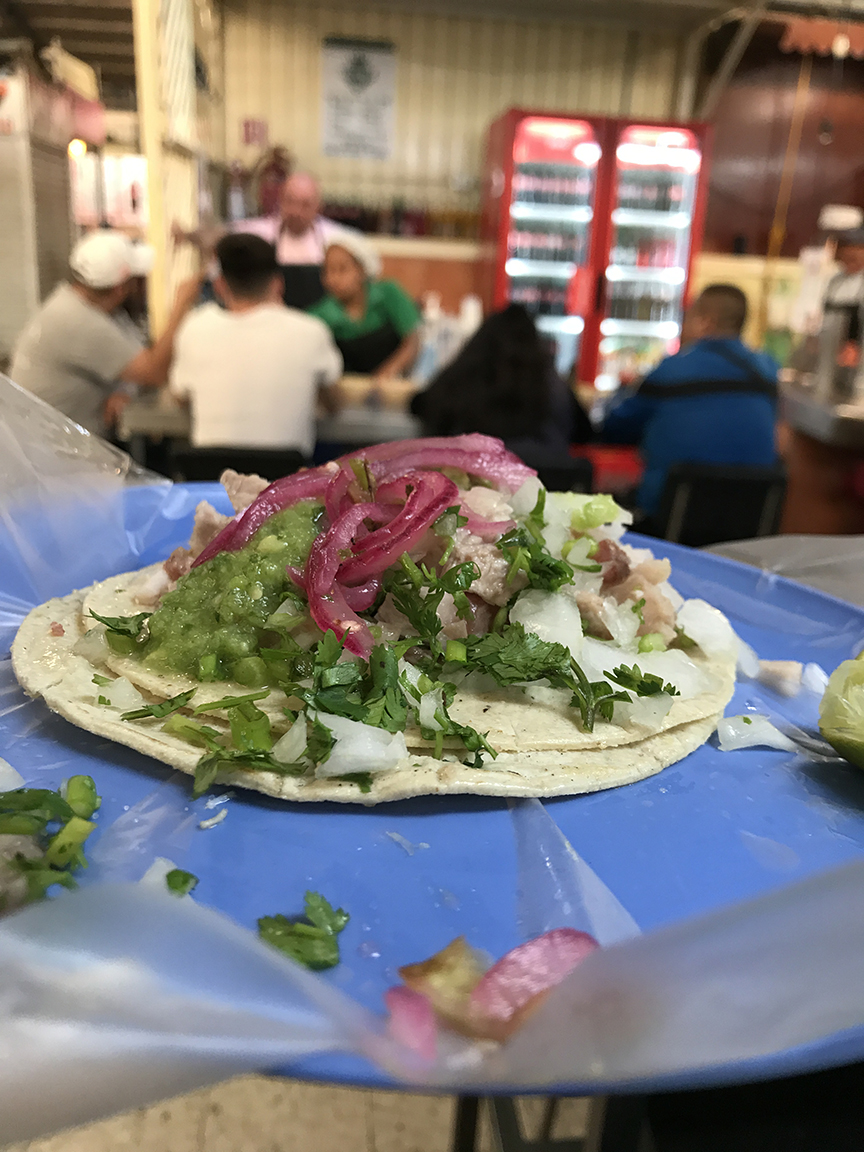
All photos courtesy Eat Like a Local Mexico City.
Once relegated to unpretentious mom-and-pop eateries, the diverse cuisine of the Middle East has graduated to sophisticated, award-winning restaurants across America.
Every Middle Eastern culture has its own food (some countries even have distinct local cuisines), but culinary boundaries are much more amorphous than national borders. Despite a surprising degree of cultural diversity, the region’s indigenous products — chickpeas, dates, pomegranates, saffron, and olive oil, to name a few — result in some universal themes, even among adversaries.
Additionally, the use of spices like turmeric, cumin, garlic and sumac contribute to consistencies from Israel to Turkey, Lebanon to Iran. The cooking of all of those distant lands is drawing unprecedented interest among American diners, who are attracted by both its exotic qualities and relative healthfulness.
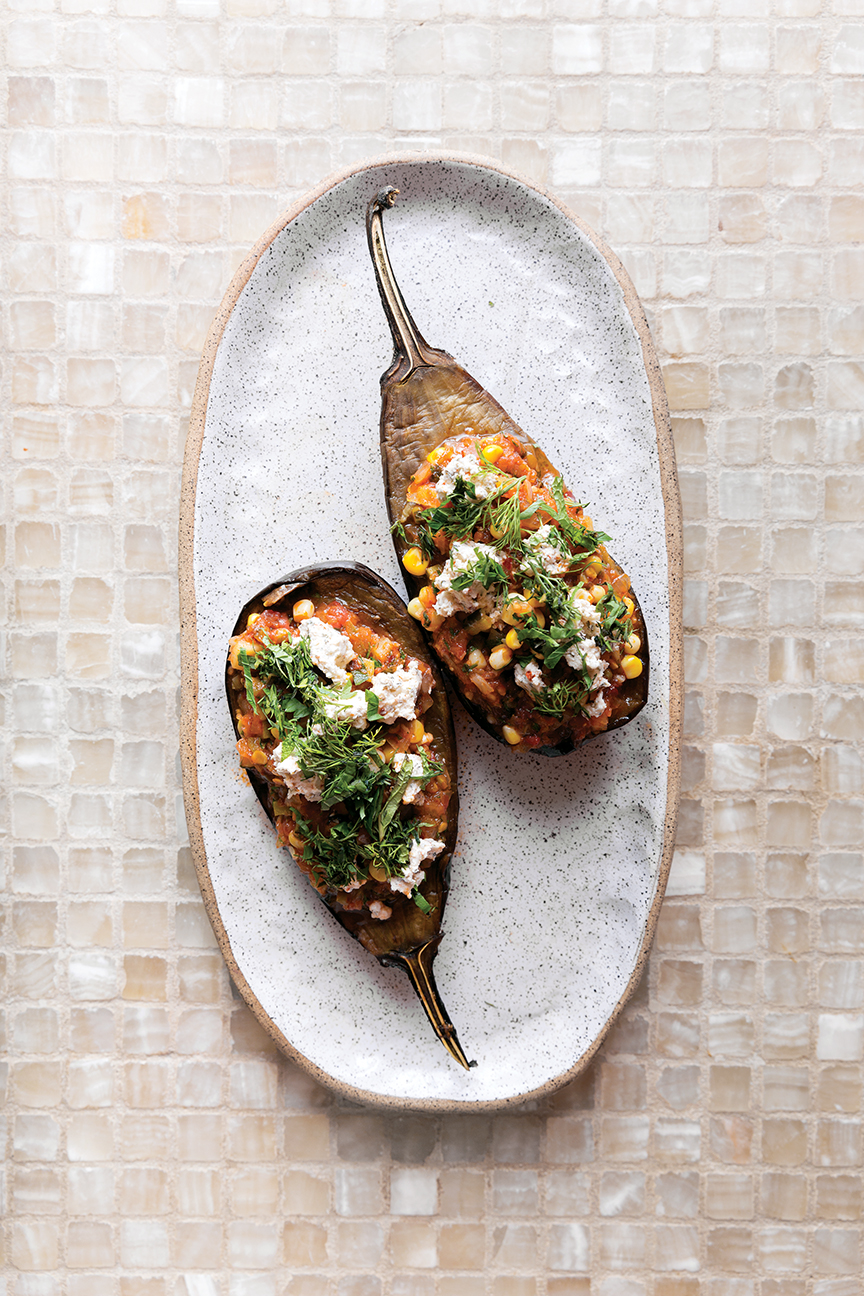
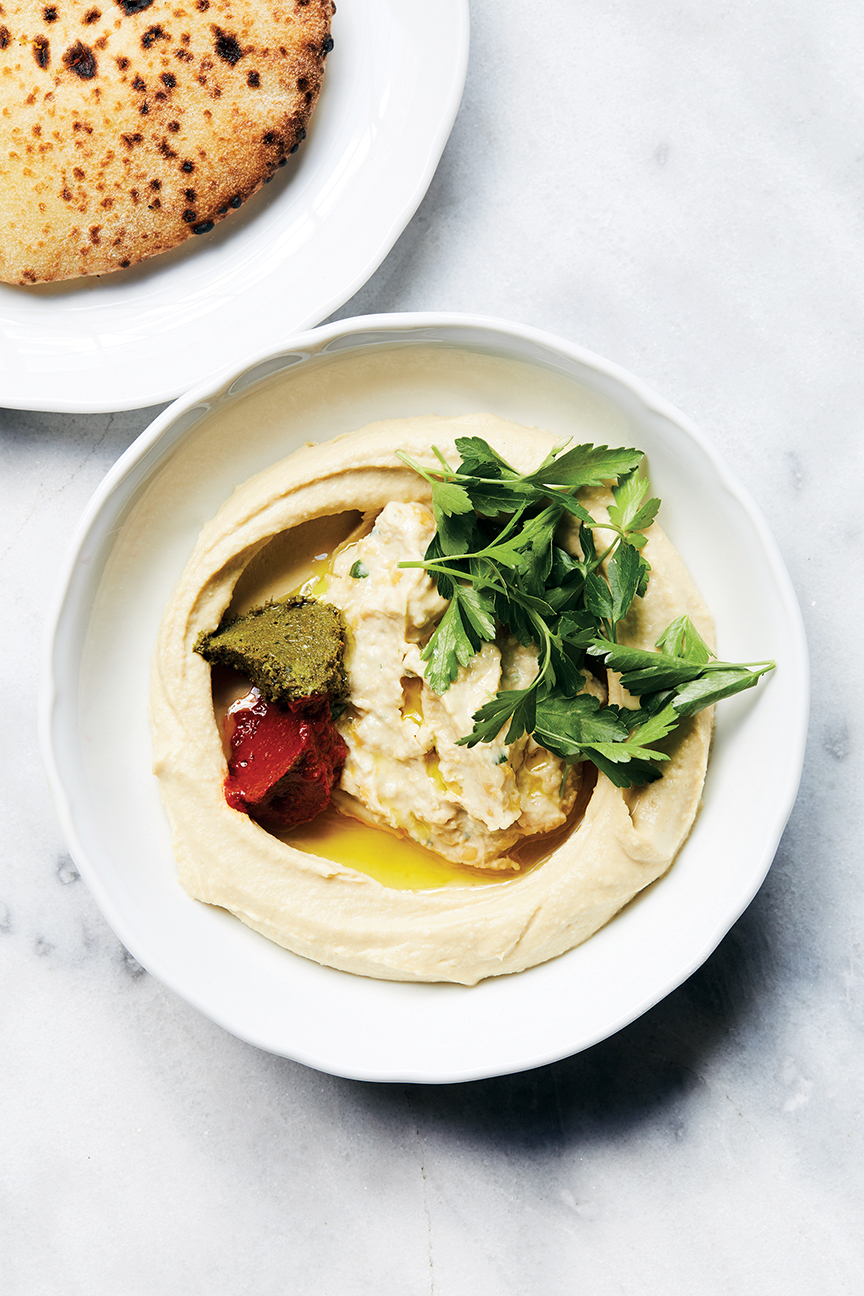
Photo by Nicole Franzen
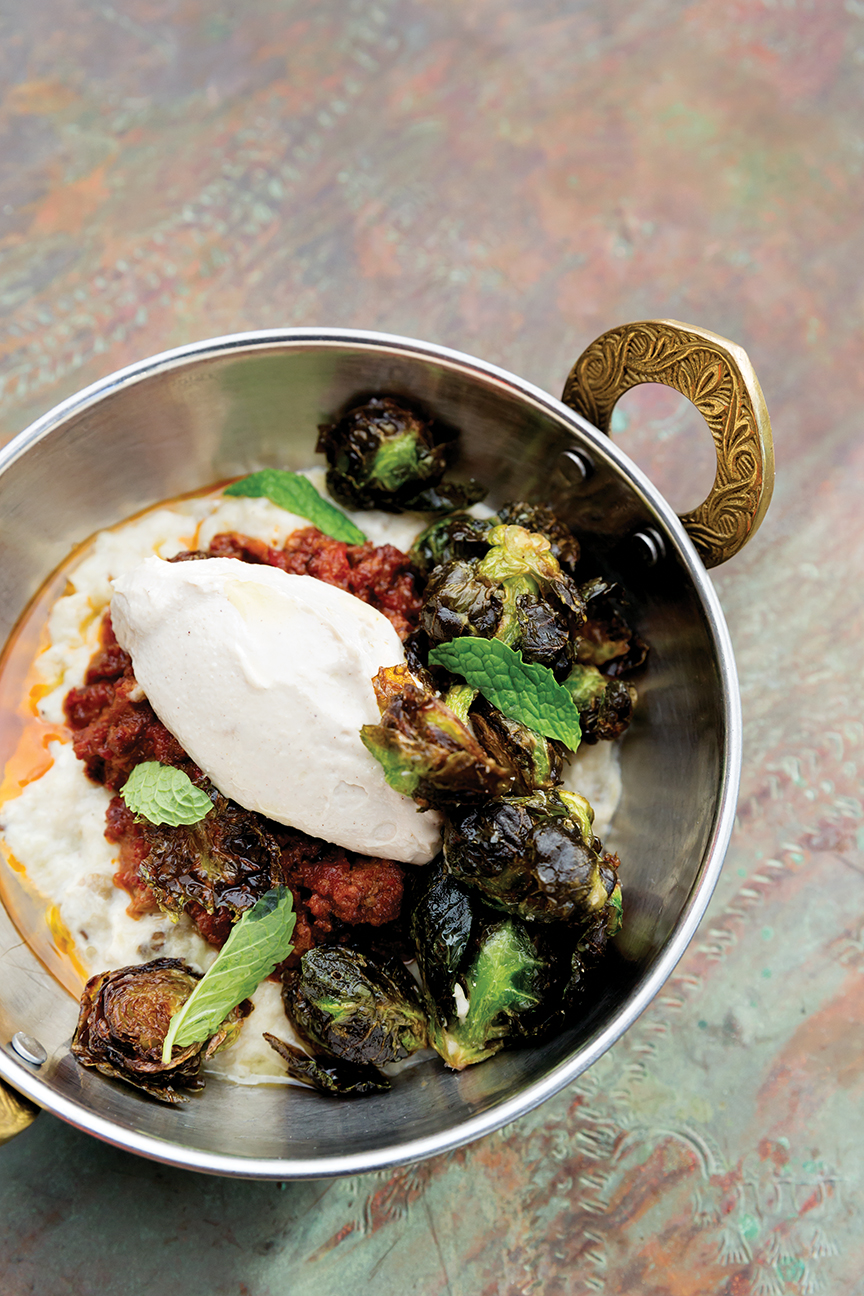
Food Photos by Kristin Teig Photography
Chef Michael Solomonov, a native Israeli who grew up in Pittsburgh, opened Zahav (“gold” in Hebrew) in Philadelphia a decade ago and has won multiple James Beard Awards for his modern Israeli cuisine. Hardly an elitist, the chef/owner is frequently found covered in flour, preparing his legendary laffa bread dough for the restaurant’s wood-burning oven. In his festive, high-ceilinged dining room, traditional lanterns hang over the bar and a photo mural of Jerusalem’s Machane Yehuda Market sets the mood.
Author of Israeli Soul and Zahav: A World of Israeli Cooking (for which he won a couple of those awards), Solomonov is pleased to introduce authentic Israeli cooking to American diners. “Zahav was our way of bringing Israeli hospitality and the soul of Israeli cooking and dining to the U.S.,” says the chef. Solomonov reports that originally the menu was very literal, concentrating on authentic Israeli dishes. “But now we’ve become more comfortable in this conduit role and the relationship that we have for being a culinary tour guide, implying Israeli food without having to copy-and-paste recipes we see over there.”
“We can’t simply call Israeli cooking ‘Middle Eastern,’” insists Solomonov, noting the diverse influences in the country, including about 100 cultures represented by Israeli residents. “We have this convergence of European, Middle Eastern and North African cuisines all happening symbiotically — that’s what makes our food Israeli,” he says.

Photo by Kristin Teig Photography
Hummus with various toppings arrives with Solomonov’s signature laffa, while other mezze include veal carpaccio with coffee-brined egg and preserved lemon, and grilled duck hearts with green garbanzos. Grilled over coals are merguez sausages, harissa-spiked hanger steak or branzino, all elevated versions of traditional dishes from Israel.
The acclaimed chef points to diversity as one of the factors contributing to the current popularity of the region’s cooking, noting that its reliance on vegetables and traditional techniques (e.g. cooking over wood) also appeal to contemporary restaurant-goers. “Diners are always looking for something new, and since there’s so much history and soul in this cuisine, I think it relates to American cooking more than people realize,” says Solomonov.
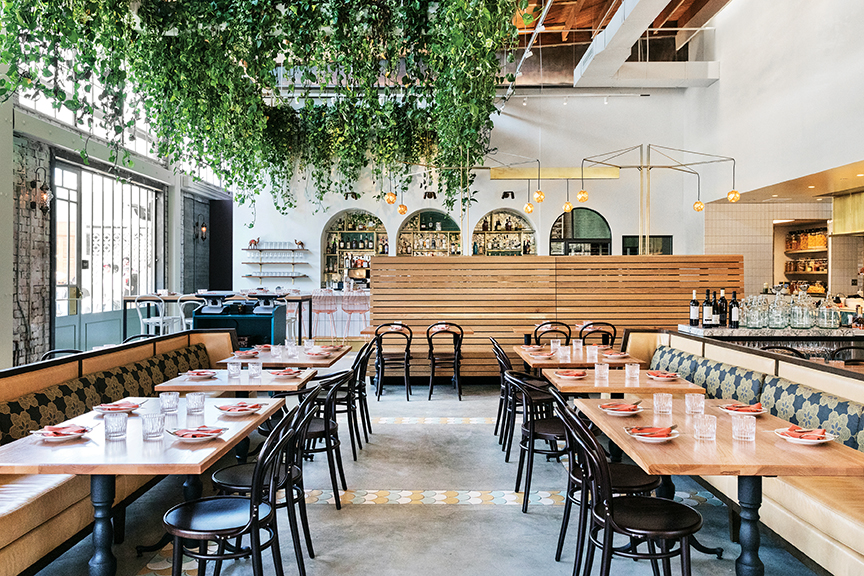
Photo by Dylan + Jeni
Bavel Los Angeles
In the Arts District in downtown Los Angeles, where crumbling factories are being transformed into chic art galleries, boutiques and bistros, young chef Ori Menashe and wife Genevieve Gergis have become prominent restaurateurs. Their first establishment, Italian-inspired Bestia, gave the Arts District culinary cred back in 2012, and this year they followed it up with Bavel, a contemporary Middle Eastern eatery.
Menashe was born in L.A., but raised in Israel, and collectively the couple also has roots in Morocco, Turkey and Egypt, so their menu at Bavel is informed by the entire region. L.A., with its large Persian and Armenian populations, is a city already accustomed to Middle Eastern cuisine, but Bavel satisfies a pent-up demand for a more sophisticated, contemporary experience. Dishes such as velvety foie gras halva, lamb tartare and grilled dorade with red charmoula delight diners.
“We always wanted to open a restaurant that showcases cuisine from our family lineage with flavors and spices we grew up with,” explains Gergis, who also serves as Bavel’s pastry chef. The couple does not believe in being limited by expectations of authenticity and is more concerned about allowing high quality ingredients to take center stage. “Everyone is always searching for authenticity, but every day in this world people are creating beautiful new works of art and delicious things to eat while only being authentic to themselves,” explains Menashe.
At Cambridge, Massachusetts’ Oleana, a mile from the Harvard campus, chef/owner Ana Sortun creates a progressive menu inspired by the cuisine of Turkey, which she fell in love with as a young chef. “The food is so rich, but nothing is heavy,” says Sortun, explaining the sophisticated use of spices in Turkish cooking is distinct from any other cuisine.
“My mission was to expand people’s perception of the Mediterranean and bring Middle Eastern cuisine into the mainstream,” says the classically trained Sortun, whose heritage is actually Norwegian. She suggests that increased travel to the region, health-consciousness and advocacy from chefs like Zahav’s Michael Solomonov are contributing to unprecedented popularity of the region’s cooking.
“I try to introduce my customers to authentic flavors, not necessarily the kind of authentic dishes I would cook if I was a native of Turkey,” says Sortun, who admits a penchant for creativity. A meal at Oleana might begin with mezze such as spinach falafel, quail kabab with a baharat spice blend, or Mediterranean deviled eggs. Larger plates include za’atar-spiced chicken with a Turkish cheese pancake or striped bass with pistachio muhammara, followed by desserts like a Turkish rendition of profiteroles.
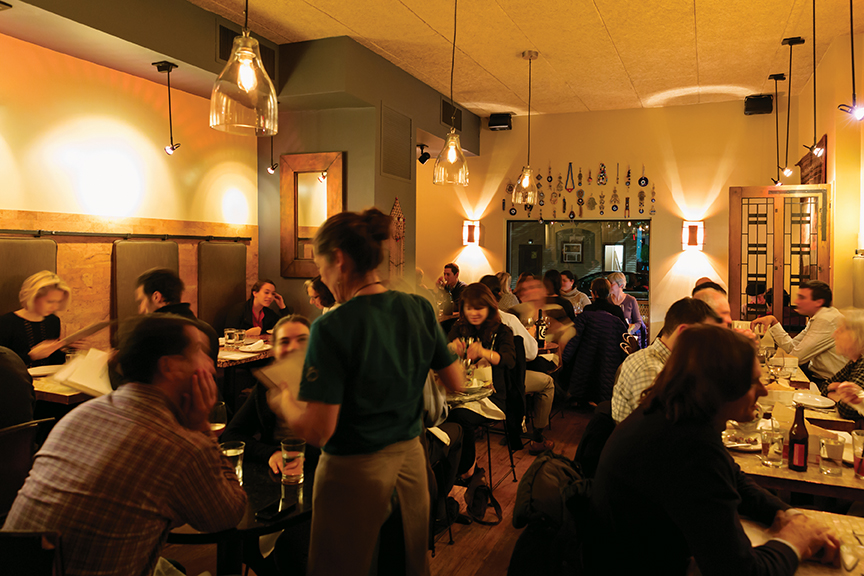
Photo by Kristin Teig Photography.
Oleana Cambridge, Massachusetts
Sortun also co-owns a casual bakery and mezze bar in Cambridge called Sofra, and Sarma in nearby Somerville where former Oleana chef Cassie Piuma presents Middle Eastern exoticism disguised as familiar American comfort foods. “We wanted Sarma to be young and accessible, with small plates and a big bar,” says Sortun, who adds, “It’s more playful, less serious than Oleana.”
Snacks at Sarma include Turkish-spiced beef jerky, brisket shawarma served taco-style, pork belly biscuit sliders layered with jalapeño-whipped feta, and a Middle Eastern riff on the iconic Philly cheesesteak. “Cassie is using language to make the cuisine at Sarma more accessible,” says Sortun, noting that expressing familiar concepts builds trust with diners.
New Orleans hardly seems the place to find exceptional Middle Eastern cuisine, but Big Easy diners are happy to take a break from gumbo and étouffée for chef Alon Shaya’s contemporary Israeli cuisine. His restaurant, Saba (“grandfather” in Hebrew), features a homey dining room and a menu that layers modern concepts over ancient traditions from the Middle East.
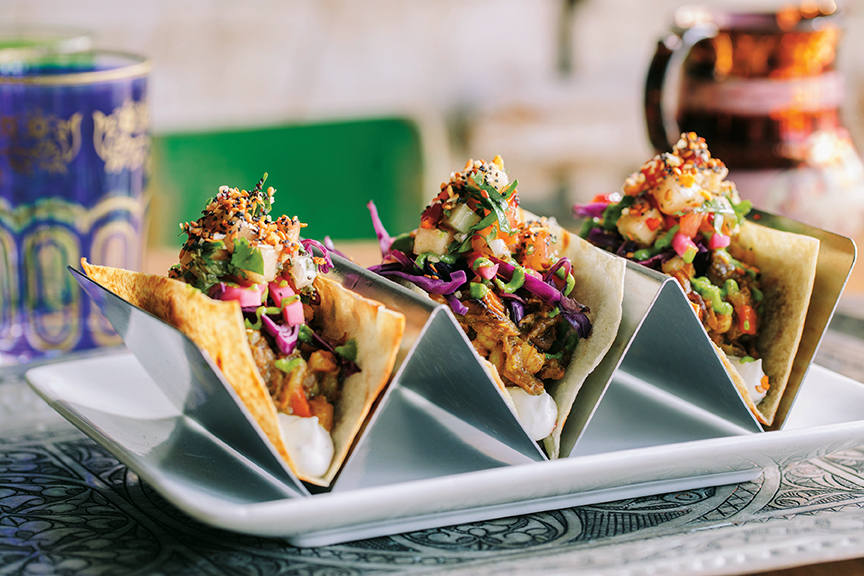
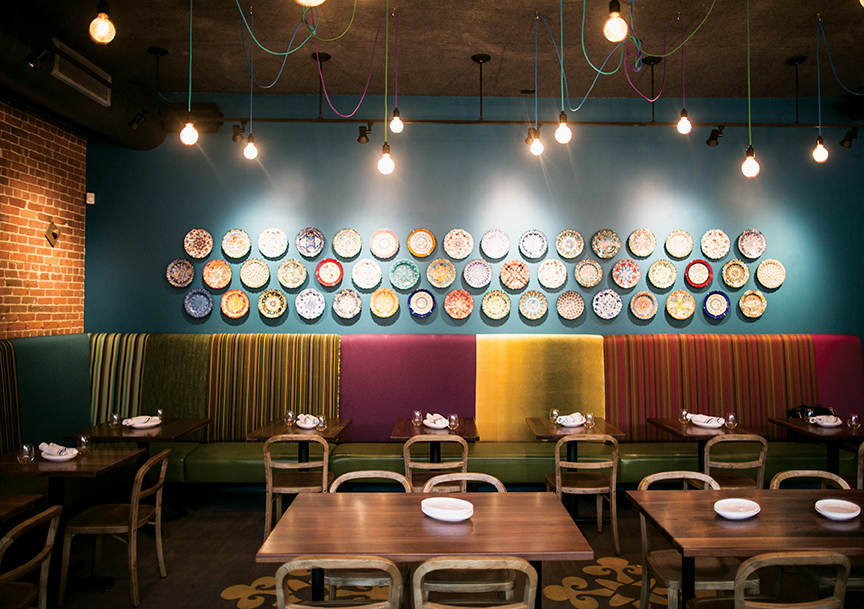
Photo by Susie Cushner.
Sarma Somerville, Massachusetts
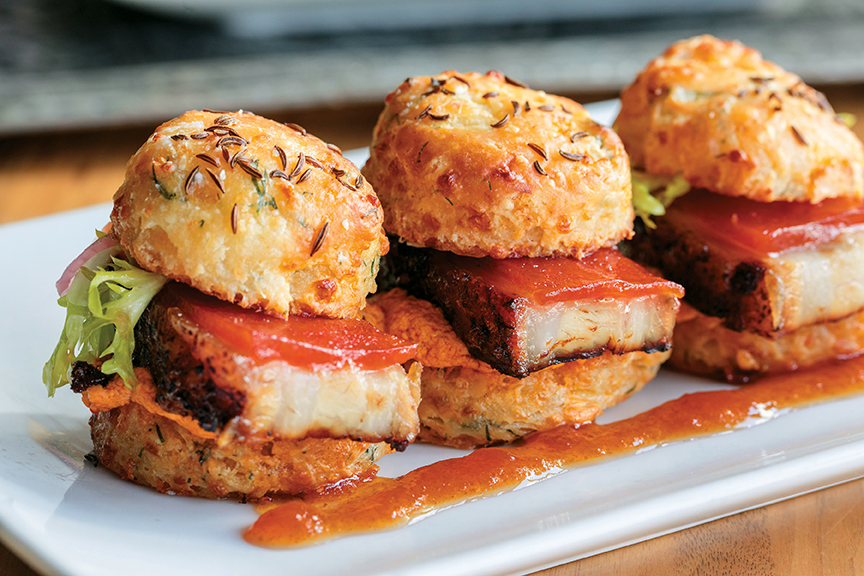
Food Photos by Brian Samuels.
At Saba, Shaya offers a selection of hummus preparations incorporating everything from spicy Brussels sprouts to blue crab, while octopus is treated with shawarma spices and foie gras is complemented with date honey and Marcona almonds. Caviar may precede family-style harissa-roasted chicken or Moroccan-inspired lamb shank pastilla.
“We don’t try to invent anything,” says Shaya, who states the restaurant’s goal is to create food that evokes memories and emotions. Concurring with Philadelphia’s Solomonov, he reports, “Israeli cuisine is different because of the immigration that occurred over the last 70 years,” with cultural influences in Israel, including Russian, Yemenite, Greek, and Moroccan. “It’s how those cuisines intermingle that make it unique,” adds the Israeli-born chef/owner.
Shaya does not necessarily subscribe to the view that Israeli and Middle Eastern cuisines are suddenly trendy. “I think it’s just good, comforting and recognizable food,” he says, adding for emphasis, “I think it’s actually anti-trendy, and that’s why so many people like it.”
Bavel Los Angeles www.baveldtla.com
Saba New Orleans www.eatwithsaba.com
Oleana Cambridge, Massachusetts www.oleanarestaurant.com
Sarma Somerville, Massachusetts www.sarmarestaurant.com
Sofia Bakery & Café Cambridge, Massachusetts www.sofiabakery.com
Zahav Philadelphia www.zahavrestaurant.com











